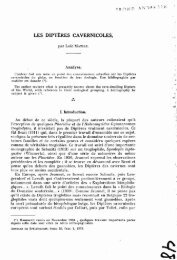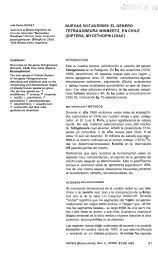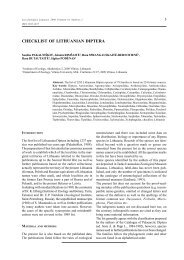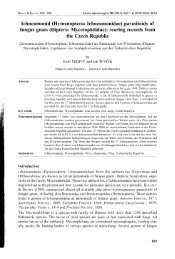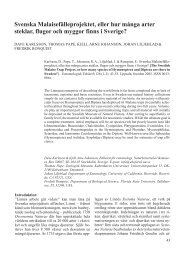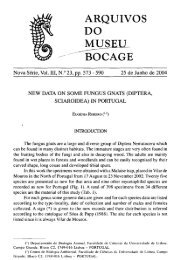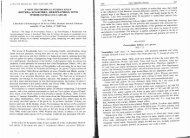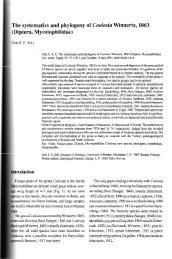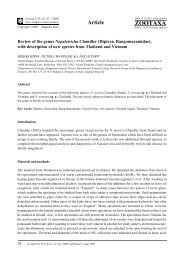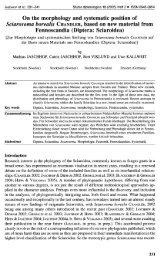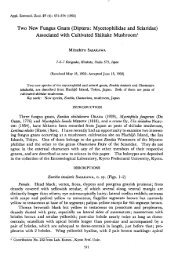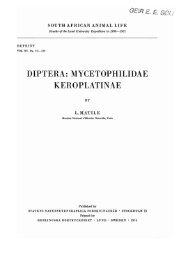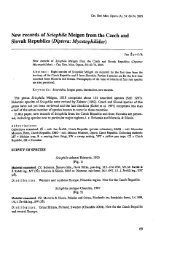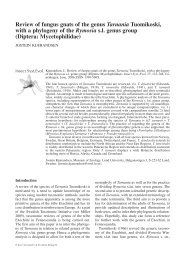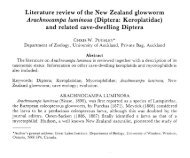Diptera Nematocera from the tains of Borneo. By FW EDWARDY ...
Diptera Nematocera from the tains of Borneo. By FW EDWARDY ...
Diptera Nematocera from the tains of Borneo. By FW EDWARDY ...
Create successful ePaper yourself
Turn your PDF publications into a flip-book with our unique Google optimized e-Paper software.
X1V.-<strong>Diptera</strong> <strong>Nematocera</strong> <strong>from</strong> <strong>the</strong> Moun<strong>tains</strong><br />
<strong>of</strong> <strong>Borneo</strong>. <strong>By</strong> F. W. <strong>EDWARDY</strong>.<br />
(JVith two Plates.)<br />
(Published by permission <strong>of</strong><br />
Museum).<br />
<strong>the</strong> Trustees <strong>of</strong> <strong>the</strong> British<br />
This report is based on two collections made in Saramak by<br />
Dr. E. Mjoberg and sent by him to <strong>the</strong> Britifih Museum for<br />
determination. The first was made on Mts. Murud and Dulit<br />
in <strong>the</strong> latter pan <strong>of</strong> 1922, and received in London in <strong>the</strong> summer<br />
<strong>of</strong> 1923; <strong>the</strong> second, <strong>from</strong> Mts. Poi and Pe~ssen, was<br />
received in April 1924. It appeared desirable to combine <strong>the</strong><br />
reports on <strong>the</strong> two collections, in order to give us as good an<br />
idea as possible in one paper <strong>of</strong> <strong>the</strong> Xematoceroos fauna <strong>of</strong> <strong>the</strong><br />
island. Thanks to <strong>the</strong> generosity <strong>of</strong> <strong>the</strong> Sarswak Museum<br />
<strong>the</strong> types <strong>of</strong> all <strong>the</strong> new speaes have been retained, as well as<br />
examples <strong>of</strong> some o<strong>the</strong>r species whlch were not previously represented<br />
in <strong>the</strong> British Museum collections. Duplicates,<br />
when available, have been returned to <strong>the</strong> Sarawak Lkfuseum.<br />
The cotlection consisted mainly <strong>of</strong> Tipulidae, <strong>of</strong> which <strong>the</strong>re<br />
were no less than 89 species represented among just under 200<br />
specimene; <strong>of</strong> <strong>the</strong>se it has been found necessary to describe<br />
51 as new. Some <strong>of</strong> <strong>the</strong> s~~ppoeed new species may perhaps<br />
be found tater on to be identical with forms described recently<br />
by Alexander <strong>from</strong> Japan or Formosa, but in <strong>the</strong> great majority<br />
<strong>of</strong> cases this is unlikely. The resl~lt is indeed hardly surprising,<br />
considering <strong>the</strong> little that was previously known about<br />
<strong>the</strong> Cranefly fauna <strong>of</strong> <strong>Borneo</strong>, and <strong>the</strong> strong tendency <strong>of</strong> members<br />
<strong>of</strong> this family to develop local and endemic species,<br />
especially in mountainous regions.<br />
So far ae I have been able to discover, <strong>the</strong> following list<br />
includes all <strong>the</strong> Craneflies hi<strong>the</strong>rto recorded <strong>from</strong> <strong>Borneo</strong>, as<br />
well as a few unrecorded species which are represented in <strong>the</strong><br />
Britiah Museum.<br />
Bar. Mua. Journ., No. 10, 1928.
1. Elsphanbmyia argsrrtoooinota 9.<br />
wak. 10.<br />
a. Orimarga 6omsauir B- U.<br />
3. Trsntspohlia (Mongoma) l%.<br />
panipsr 0. 8. 18.<br />
4. Eriocsm bomsam Eda.<br />
5. ,, combimta W&. 14.<br />
(diluta Wak.).<br />
6. ,, in* W&. 15.<br />
l. , I U M ~ Wmb. 16.<br />
8. .. lunigsm W& 17.<br />
(optabdir Wak.) M.<br />
Brioom ornab End.<br />
, pywhooh- Walk. S<br />
, rubrrosnr W&<br />
, orrficdi.Wld<br />
Ctunaorowslir pibdw<br />
v. d. W.<br />
, umbrirur WId.<br />
F+& cinctiprr db Mqi.<br />
,. magnicomir End.<br />
psdata Wld.<br />
.:' pmatiftoru<br />
6<br />
Only 7 <strong>of</strong> <strong>the</strong>se 18 species are represented in <strong>the</strong> present wl- 3<br />
lections so that <strong>the</strong> total number <strong>of</strong> Craneflies now known <strong>from</strong><br />
<strong>Borneo</strong> is 100. This <strong>of</strong> course can only be a amall £raction <strong>of</strong><br />
<strong>the</strong> number which occurs.<br />
The four Mycetophilidae described here are, I believe, <strong>the</strong><br />
firet members <strong>of</strong> thls family to be recorded <strong>from</strong> <strong>the</strong> island.<br />
In regard to <strong>the</strong> Culicidae. Mr. J. C. Moulton has published<br />
(in 13th Report Sarawak Museum, 1925, pp. 46-48) a lid<br />
<strong>of</strong> <strong>the</strong> 99 species known h m <strong>Borneo</strong>. The present collection<br />
contained only three apecies, but it was a surprise tp b ver<br />
that all <strong>of</strong> <strong>the</strong>se were additiom to <strong>the</strong> Bornean lint, two being<br />
apparently undescribed.<br />
MTCETOPHILIDAE.<br />
~c~ocm.4 BIPABCUTA sp. n. (Plate 9, fig. 1.)<br />
$. He J browniah ochreous, ocelk pot black, fece $0<br />
yellow. Antennae ochreous, appearing darkened on <strong>the</strong> apical<br />
half owing to <strong>the</strong> denser pubesence. First dagellar segment<br />
about three times as long as <strong>the</strong> scape, wcond and third ra<strong>the</strong>r<br />
ahorter, fourth equal to <strong>the</strong> firat, l& without long bristly hair.<br />
Palpi yellow. Keck white. Thoraz uniformly shining black.<br />
bristles black. Abdomen yelled with black apical bands on<br />
each <strong>of</strong> tergites 1-5, that on tergite 9 <strong>the</strong> brdest ; segment0<br />
&Q all blackish. Claepers with <strong>the</strong> umal two teeth. Legs<br />
with <strong>the</strong> coxae shining black, tmchantera and fore and mid<br />
femora and tibia ochreous; tad dark; hind femom and Wise<br />
blackish brown except at <strong>the</strong> base and tip. Wings aa figured.<br />
h'o macmtrichia. Helterea black.<br />
Length <strong>of</strong> body 8 mm. : wing 5 mm. ; enbnueo P2 mm.<br />
Mt. Penrieeen, 4600 feet-l $,<br />
i<br />
9<br />
i<br />
f<br />
There in a demeged female <strong>of</strong> this species in <strong>the</strong> Britisb<br />
Mwum <strong>from</strong> Biem (Tab, 18th Janusry, 1920. H. C.<br />
Bobineon and h'. hmandale).<br />
. .<br />
mm pmmeemsre sp. n. (Plate 10, fig. 93.)<br />
af. ,Heud dark brown, ocelli encloeed in a black spot, <strong>the</strong><br />
middle one small. antennm with <strong>the</strong> ecape ochreous, flagellum<br />
black, <strong>the</strong> segment0 cylindrical and about twice as long as<br />
b d . Palpi ochreous, <strong>the</strong> firat two segments brod.<br />
Thorcrz brownish ochreone, without markings ; memnotum with<br />
nhort black bridles, very dense over <strong>the</strong> wing-mote; pleurotegitee<br />
bare; postnotum not prominent, but with a few<br />
small bristles at its tip. Abdomen mostly ochreous, <strong>the</strong> %gments<br />
with trident-like apical bands, due to black pigment<br />
ahowing through <strong>the</strong> integument (<strong>the</strong> bands might not be visible<br />
in a dry w e n ) . Hypopygium as figured. Legs Iight<br />
ochreous, t ~bm and tarei darker, <strong>the</strong> fine setae arranged in<br />
vary regular row; firat segment <strong>of</strong> front tarsi quite one-third<br />
longex than <strong>the</strong> tibim. Wings with a sIight yellowish tinge;<br />
a brown baud just before <strong>the</strong> tip, extending <strong>from</strong> R, into cell<br />
M,, and a very dietinct brown shade over <strong>the</strong> tip <strong>of</strong> Cu,.<br />
Thid costal divieion about two-thirds as long as <strong>the</strong> fourth;<br />
coeta reaching half-way <strong>from</strong> R, to <strong>the</strong> tip <strong>of</strong> M,, An nearly<br />
if not quite reaching <strong>the</strong> mar@ (wing slightly damaged in this.<br />
poaition). Hslteree white.<br />
Length <strong>of</strong> body 5.5 mm. ; wing 4 mm.<br />
Mt. Penrieeen, 4600 feet1 af.<br />
This ie. apparently new to P. fininentris Brun. than to<br />
any o<strong>the</strong>r deecribed Oriental species, Mering in <strong>the</strong> longar<br />
front tarsi, etc.<br />
af. Heud black. Ocelli dietinct and placed on a ra<strong>the</strong>r<br />
prominent tubercle, middle one small. Eyes large, in contact<br />
with <strong>the</strong> lateral ocelli. Front not sunken as it is in <strong>the</strong> Amencau<br />
epeciaa. Bntennae yellow, except segments 5-6 and 10-<br />
, 16, which are black&; flageller eegments as long as broad,<br />
except <strong>the</strong> last (16th), which ia nearly three times as long.<br />
Pmboecin ochreous. Thoraz brownish ochreous, pleurae with<br />
dark brown markings. Abdomen dark brown, eegments 2-6<br />
each with a narrow baeal ring, hypopygium yellowish. Legs<br />
with <strong>the</strong> wrae dark brown, <strong>the</strong> front pair ochreone at <strong>the</strong> bses ;
946 DIPTERA NEYATOCERA.<br />
trochanters browniah ; femorm ochreous, narrowly dark at <strong>the</strong><br />
baae, <strong>the</strong> hind pair with <strong>the</strong> apical half black; tibis ochreous,<br />
<strong>the</strong> hind with <strong>the</strong> tips broadly black; front and middle tarsi<br />
brownish, hind tarsi black; first sa-ment <strong>of</strong> front tarsi nearly<br />
twice as long as <strong>the</strong> tibia. Wings yellowish-tinged, with a<br />
brown pattern as shown in <strong>the</strong> figure. Halteres yellow.<br />
Length <strong>of</strong> body 7.5 mm. ; wing 4 mm.; proboscis 2.5 mm.<br />
Mt. Munid. 7000 feet. October-l $.<br />
KO very near ally <strong>of</strong> this species has been described, but a<br />
ra<strong>the</strong>r similar Weut African form is represented in <strong>the</strong> British<br />
Museum collection. L. asintiro White (Ceylon) is a much<br />
smaller species with unmarked wings.<br />
EXECHI.~ P.4LLIDUL4 sp. n. (Plate 10, fig. 24, 25.)<br />
Head bromnish ochreous, fare pale ochreons. Antennae<br />
uniformly brownish ochreous. palpi lighter. Thoraz uniformly<br />
brownish ochreous. Scutellam with two strong black hristles<br />
end two smaller ones between <strong>the</strong>m. Abdomen with <strong>the</strong><br />
first tercite dark hrown, its p<strong>of</strong>iterior horder pale ochreous;<br />
tergites 2-4 in <strong>the</strong> c? entirelv ochreous; in <strong>the</strong> Q terpte 2<br />
ochreous with a dark hmwn median stripe which i~ widened<br />
in <strong>the</strong> middle and at <strong>the</strong> tiu. tereite 3 ochrenn~. torcite 4 hlackish.<br />
terzite 5 ochreo~ls. with <strong>the</strong> hind marlin dark; tergites 6<br />
-7 in <strong>the</strong> cf dnrk brown, in <strong>the</strong> Q hlnckish. Hvpopygium as<br />
fimred; ovinositor ron~tnlcted almost exactlv as in E. panida<br />
8tm. Law ochreons, tarsi dn.rkened : tihia.1 mines black, .<br />
ra<strong>the</strong>r lonrr. Winqs with a sliqht v~llowiah tin*; Rs very<br />
sli~htlv cnmed dom at <strong>the</strong> tin ;*m about three times as long<br />
as <strong>the</strong> median fork: tins <strong>of</strong> .W, a.nd M, not ramchine <strong>the</strong> wingmarlin<br />
: fork <strong>of</strong> Cli rrll herond <strong>the</strong> ha*e <strong>of</strong> Rs : Ax lon~ and<br />
strnizht. nlmst r~nchinp <strong>the</strong> marlrin. Ralteres whitish, baae<br />
<strong>of</strong> knob darkened.<br />
Lenqh <strong>of</strong> hodv 4.5 mm.; rrino 4 mm.<br />
Vt. M-:rt~d hot. nrtn1,er-1 rf 1.0 in ropula.<br />
?Lie i.- r!oce!o n!liad tq tbe E~~rone~n E. vnllida Sten..<br />
evrn r!x hv-ooyoi?.l stnl~tlwe heiw vnrv similar. There<br />
aooevr. t.nret~r. to he 00rem.l np:&rIv allied nriental specier, <strong>of</strong><br />
tbi: rntlp : vrh nre E. hnnilincrr Rnln. and E. Paca White.<br />
me h-t dimtin~tion between thppe sne~ie~ is ~erhaps to be<br />
found in <strong>the</strong> shape <strong>of</strong> <strong>the</strong> large eiqhth sternite <strong>of</strong> <strong>the</strong> male.<br />
EXWCHIA up. inc.<br />
MC. Dr~lit, 3000 feet1 gP,<br />
d. Head black. Antennas black, except for <strong>the</strong> wmnd<br />
segnent. which is ochreolls. Flagellum appnrentlv with pinlit<br />
segments onlv. firat as lone as broad. next three hronder than<br />
Ion? but di~tinctly separated and forminc a ~ort <strong>of</strong> clllh.<br />
Thorns with <strong>the</strong> pronotnm. muturn and rrrutellilm nniformly<br />
red. postnotnm and pleurae ra<strong>the</strong>r dnrk hrown. -4nterinr<br />
p~nnntal comh vith two _aronpa <strong>of</strong> four teeth. noptcrior rovh<br />
with two teeth at each side, one n!wad in front <strong>of</strong> t l o<strong>the</strong>r. ~<br />
and hetmeen tbe~e a rom <strong>of</strong> six smaller teeth. Abdomen<br />
bromish red. dtrrker at tl!r tip. I,coc with <strong>the</strong> come and<br />
trnchnnters oranre. fmnt fenlor- rrddich. rlnrker nt Iv=e and<br />
tin. nncterior fcmora dark hrnvn. lighter nt L~IP hose. tikiae nnd<br />
tarsi hlark. Proximal rnmh <strong>of</strong> fmnt tibiae with three sr~ines<br />
in a transver~e row. and a, lolirth lnorP diatallv nlncetl on <strong>the</strong><br />
ovter side. Vlnoc hrnnnish. darker tm-n+s costa.. dips U<br />
little darker still: all veins ahont ennnllv dark. Ba.ca.1 s~rtion<br />
-<strong>of</strong> Rs verv ~hort. liarelv a third ns lon~ as W : median fork<br />
with a short fitalk: m-crr ~lmod rertiml. not or~twardly<br />
olilinne rs in <strong>the</strong> Enronenn r~eries. Ralteres black.<br />
"r' Tfmrrth <strong>of</strong> hodv 4 mm.: wing 4 mm.<br />
Mt. Mv?-~*rl. 7000 feet. Ortoher-1 Q.<br />
The allied D. nigrktinmn de Meii. differs in <strong>the</strong> dnrk<br />
scutellnm and <strong>the</strong> more nnmerolls teeth in <strong>the</strong> posterior pronotal<br />
comb, alao in <strong>the</strong> briqhter red posterior femora.<br />
Cmlrcom~s cmamomnos v. n. (Plate 9. fig. 3; Plate 10,<br />
fig. 26.)<br />
Q. Hend black, antenn~e and palpi dark brom: e~es<br />
just touching. La~t five 0agellnr se-ments nhout threeqnarters<br />
as long as <strong>the</strong> first eiyllt: firfit 0qellnr secment<br />
ullortly oval. nest 7 0a~k-shaped, hut rery little enlarced at <strong>the</strong><br />
base. ,md~~ally becoming more elonwte. Palpi slender, <strong>the</strong><br />
antepenultimate sement scarr-ely enlarged on <strong>the</strong> inner side.<br />
Thmaz mmtly yellowish %hove; mesonotnm dark brown in<br />
front; scutellurn narrowly (lark brown at <strong>the</strong> sides, p~tnotum<br />
similarly coloured at <strong>the</strong> sides and apex. Two scutellw hri+<br />
tles, close toge<strong>the</strong>r. Pleurae largely dark, Abdontcn dark
Vol. 1x1. (Part In.) No. 10, 1828. Plate 10.<br />
Sar. .I/Rs. Joum. .-. .--.<br />
Fig. 7. Limnobia n'tr<strong>of</strong>ocdir BP. n Q.<br />
ar8-+-.~rp.n 9.. .<br />
. , l&, totai. bipuctab #p. n b. ..<br />
,,; - A . Tr- omubpnuu ep n Q., .<br />
, rr. ; fk=o?hiIf (Dw-PhnVa? ap. n 9-<br />
, 1~: 1; , r I, mamiiithorm #p. n Q. .<br />
,,la-.:8;, . . ~~ sp. n d.<br />
U. - f* , i (~d;tda) PwarU-rp. F. d.<br />
, 16. ,F m #p. n. d.<br />
, 16. , (&h&) duliCnuuTa. 0.<br />
l . gmubto ap. n d.<br />
, , (~,b'~bp&) mmticoia ap. n d.<br />
,, 19. BGocrra murudarir up. n d.<br />
,. 20. Mibpr~a mjsbsrgi #p. n d.<br />
,, !U, Dolichaprsa cwwata ap. n d.<br />
, B. Naqssa p@h~ BP. P d.<br />
Explanation <strong>of</strong> Pbte 10.<br />
- 9<br />
.- - .<br />
Deteil~ <strong>of</strong> male hypopygie, etc.<br />
.<br />
pig, ar PLtyura pmriuastui. rp n d *Mum<br />
If ab. h h b<br />
f m m - u<br />
24% kdiapdlidtrl.q.n.dhppyg!um<strong>from</strong>sbova<br />
1JLidda m n. d h m ~ u <strong>from</strong> m blow. .bo<br />
' ,, W. Hdw famiu& #p. n. d dupan.<br />
,, 8L Brioptma coovminir ap. n d -mum ham &we.<br />
,, 33. Mdophilw dbio8pr .p. n d hypopy~<br />
fnna bna~th:<br />
,. 8b Mobphi+ d w .p. n d hyppygium, h.U dd. new.<br />
M. MW (h *B) W<br />
d ~XODI<br />
'. \v. E. dd.<br />
DIPTERA NEYATOCERA
Vol. 111. (Part 111.) No. 10, 1926, Plate 10.- -<br />
Sar. M~is. Journ. *.' T: ,'F.-, c:-,' .-:v. mJ--. A, l.3LL v LA-<br />
DIPTERA NEMATOCERA.<br />
I:. \V. B. del. Vaus 6 Cramfiton, Ltd.



